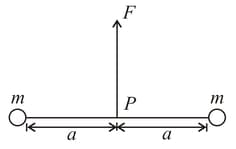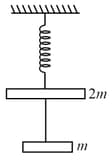Newton’s Laws of Motion
Newton’s Laws of Motion: Overview
This topic covers concepts such as Linear Momentum, Equilibrium of Forces, Lami's Theorem, Application of Lami's Theorem, Newton's Laws of Motion, Newton's First Law of Motion, Concept of Inertia, Inertia of Motion, Inertia of Rest, etc.
Important Questions on Newton’s Laws of Motion
Physical independence of force is a consequence of,
A block of mass is placed on a smooth wedge of inclination . The whole system is accelerated horizontally so that the block does not slip on the wedge. The force exerted by the wedge on the block ( is acceleration due to gravity) will be
A lift weighing is moving upwards with an acceleration of . The tension in the supporting cable is
Two cubes of masses and be on two frictionless slopes of block A which rests on a horizontal table. The cubes are connected by a string which passes over a pulley as shown in the figure. To what horizontal acceleration f should the whole system (that is the blocks and cubes) be subjected so that the cubes do not slide down the planes? What is the tension of the string in this situation?
Two particles of mass each are tied at the ends of a light string of length The whole system is kept on a frictionless horizontal surface with the string held tight so that each mass is at a distance from the centre (as shown in the figure). Now, the mid-point of the string is pulled vertically upwards with a small but constant force As a result, the particles move towards each other on the surface. The magnitude of acceleration, when the separation between them becomes is

The string between blocks of mass and is massless and inextensible. The system is suspended by a massless spring as shown. If the string is cut find the magnitudes of accelerations of mass and (immediately after cutting)

A block of mass is placed on a horizontal frictionless plane. A second block of mass is placed on it and is connected to a spring of spring constant the two blocks are pulled by distance . Block oscillates without slipping. What is the maximum value of frictional force between the two blocks?

Three identical blocks of masses are drawn by a force on a frictionless surface, then what is the tension (in ) in the string between the blocks and ?

A player caught a cricket ball of mass moving at a rate of . If, the catching process is completed in , the force of the blow exerted by the ball on the hand of the player is equal to
A particle of mass is subjected to a force with . What will be its initial acceleration if it is released from a point away from the origin?
A machine gun fires a bullet of mass 40 g with a velocity 1200 . The man holding it can exert a maximum force of 144 N on the gun. How many bullets can he fire per second at the most?
A rocket with a lift-off mass is blasted upwards with an initial acceleration of . Then the initial thrust of the blast is nearly –
A light spring balance hangs from the hook of the other light spring balance and a block of mass hangs from the former one. Then the true statement about the scale reading is –
If suddenly the gravitational force of attraction between earth and a satellite revolving around it becomes zero, then the satellite will –
A body of mass hangs at one end of a string of length , the other end of which is fixed. It is given a horizontal velocity so that the string would just reach where it makes an angle of with the vertical. The tension in the string at mean position is
How did you find the Equilibrant force in this make up lab?
What is meant by Equilibrant and resultant?
What are the 3 types of equilibrium?
